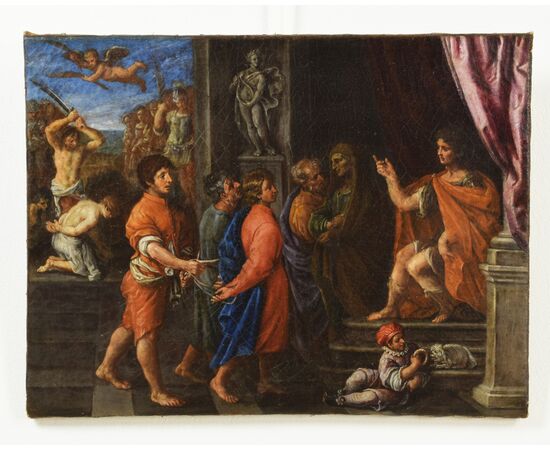Giuliano Dinarelli, The condemnation and martyrdom of the four crowned saints, oil on canvas
Giuliano Dinarelli (1629-1671)
The condemnation and martyrdom of the four crowned saints
Oil on canvas, 47 x 61 cm
Mid-17th century
Price: contact by phone
Item accompanied by a certificate of authenticity and expertise (attached at the bottom of the page)
The painting depicts the condemnation and martyrdom of the four crowned saints: Claudio, Nicostrato, Castorio, and Sinforiano. In the foreground on the right, behind a curtain and raised on three stone steps, sits the figure of a king with an arm raised in a commanding gesture: this is Emperor Diocletian pronouncing the sentence, pointing to a classical sculpture of the god Apollo. Two men with bound arms are led before him. To the left of the king, two other men, perhaps members of the tribune, take part in the scene. On the left, in the background, two men, kneeling and with their arms tied behind their backs, are undergoing martyrdom, as indicated by the fierce gesture of the man who, with raised arms, supports a long sword, shortly before engaging in the massacre. Next to them, a group of people and armed soldiers observe; in the sky, a winged putto carries the palm of martyrdom. The subjects are depicted in historical attire, and the foreground scene is set inside a palace with a marble floor. A jester sits on the steps, playing with a little dog.
Claudio, Nicostrato, Castorio, and Sinforiano, depicted in the work, two before Diocletian and two during martyrdom, were skilled stonemasons. According to hagiographic tradition (it is the Gregorian Sacramentary of the 7th century that offers some sparse information), they worked in the marble and porphyry quarries of Sirmium in Pannonia (the current Serbian city of Sremska Mitrovica). Their skill led their fellow workers to consider them magicians because, before starting a job, they drew signs of the cross, reciting hymns and prayers, mistaken for magic formulas. Emperor Diocletian, having gone to Pannonia to find marbles for his buildings, greatly admired their artistic quality and ordered columns and decorative elements for his palace in Split, Dalmatia, which he built between 293 and 305 AD. However, one day he commissioned them, in addition to cherubs, victories, and mythological figures, a statue of Aesculapius, the god of health. The four artists, being secretly Christian, executed everything they were asked, but not the statue of the pagan deity, which they refused to create. Questioned directly by the emperor, they confessed their religion. They were tried and flogged by the tribune Lampedius, so that they abjured their faith. Faced with their refusal, they were locked in lead boxes and thrown into the waters of the Danube River. Simpliciano, a Christian and their workmate, recovered their remains trying to give them burial. Surprised in the gesture, he was also condemned to death. In the Middle Ages they became patrons of masons, stonemasons, sculptors, and building corporations. The depiction of their condemnation and martyrdom is quite rare in painting. However, it is possible to outline the iconography, which highlights some characteristics: the number of martyrs, the emperor who indicates the idol, and the palm of martyrdom.
The scene depicted in the work under study, therefore, portrays Diocletian in the act of showing the statue, in this case, of the god Apollo, which the stonemasons refuse to worship. On the right, the actual martyrdom takes place: two of the saints are flogged and finished off with swords, while from the sky an angel presents the identifying palm of martyrdom. The statue depicted is to be identified as that of Apollo Citharoedus, distinguished by the cithara and the cloak. There are several Greco-Roman sculptures that depict him with different compositional variations, one of which may have been freely interpreted by the painter.
On the back of the canvas, a label bearing the inscription in ancient calligraphy "Giuliano Dinarelli Ping(eb)it" is affixed to the frame. The work therefore appears to have been assigned in not recent times to the Bolognese painter Giuliano Dinarelli (1614-1629). The stylistic comparison with works by the artist suggests this plausible attribution, although the corpus of certain and attributed works to Dinarelli is still very scarce today. Equally scarce is the information on the life of the painter, who we know was a very dear pupil of Guido Reni. Dinarelli was born in Bologna, brother of Tadea Dinarelli, mother of Giovanni Girolamo Bonesi. The latter trained in his uncle's workshop, before finishing his painting studies with Giovanni Maria Viani. Lanzi includes Giuliano Dinarelli among Guido Reni's pupils and in the inventory of Count Antonio Baglioni of 1680, his works are reported as two octagons with Saints. Among the known works there is also the painting depicting the Guardian Angel made around 1660 and kept in the pillar between the seventh and eighth chapels to the right of the Church of Santa Maria dei Servi, in Bologna. The work is remembered in all historical sources and in the guides of the city and is, in the corpus of known works of the painter, the most famous. Dinarelli is remembered active in Bologna and specialized in religious scenes. The Diocese of Imola preserves some canvases by the painter depicting an Ecce Homo, a Madonna Addolorata, Saint Peter, and Saint Mary Magdalene. Through the letter of Ferdinando Cospi to Leopoldo de' Medici of 1675, we also learn of a Portrait of a woman that Cospi himself offers for sale, asserting that it is a work "made by a master known to me not long ago dead called Giuliano Dinarelli, one of the good pupils of Guido Reni who painted very well and imitated his master". Finally, the existence of a painting by Dinarelli depicting Antonio Colonna is evidence of a prestigious commission and, therefore, of an artistic recognition that the painter had among the nobility of the time.
The work, in good condition and recently restored, is enhanced by an important contemporary carved and gilded frame.
Carlotta Venegoni

